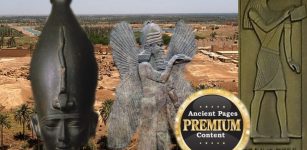Madagascar Cave Art Hints At Ancient Connections Between Africa And Asia
AncientPages. com - Unique, prehistoric rock art drawings have been discovered in the Andriamamelo Cave in western Madagascar.
I was part of a team that discovered and described these ancient treasures. They’re the first truly pictorial art, depicting images of nature with human-like and animal-like figures, to be seen on the island. Until recently, rock art in Madagascar had only yielded a few sites with basic symbols.
Andriamamelo cave art panel. Image credit: David Burney, Professor of Conservation Paleobiology, National Tropical Botanical Garden, and Adjunct Professor, University of Hawaii
The dramatic discoveries contained several surprises, including hints at some remarkable cultural connections.
First, scenes depicted in some cases linked up fairly directly to Egyptian religious motifs from the Ptolemaic period (300-30 BCE).
Second, other inferences from symbols and writing on the walls showed connections to the Ethiopian and Afro-Arab worlds.
Finally, prevalent symbology and motifs evoked a two-millennia-old cave art style from Borneo.
An additional realm of surprises: at least three extinct animals of Madagascar (thought to have been extinct for many centuries) may be depicted – a giant sloth lemur, elephant birds and a giant tortoise.
It has long been believed – and evidence has confirmed – that the people, language, and culture of Madagascar are rooted in distant ancient connections to Borneo, an island in south-east Asia, combined with strong influences from continental eastern Africa.
However, who the first Malagasy were, when they arrived, and what they did after that, are all hotly debated topics.
Though our findings are speculative, any information that might be derived from the Andriamamelo Cave evidence is of considerable interest to the reconstruction of Malagasy early history.
Connections beyond Madagascar
Our research group – including Malagasy scientists from local institutions, and American, British and Australian specialists – visited the site near the village of Anahidrano on the north-west edge of the 17,100-hectare Beanka protected area in 2013.
Anubis. Image credit: David Burney, Professor of Conservation Paleobiology, National Tropical Botanical Garden, and Adjunct Professor, University of Hawaii
Our team spent several days recording the images, surveying and mapping the entire cave, searching for associated archaeological sites, and interviewing local villagers regarding the art. It took several years, however, to search through relevant literature and museum archives to confirm the uniqueness and significance of what we’d found.
We made digital copies and hand-drawings of 72 cave-art objects. These were drawn in black pigment and included 16 animals, six human forms, two human-animal hybrid forms, two geometric designs, 16 examples of an M-shaped symbol, and many other patterns and indistinct forms.
Egyptian connections are hinted at in eight major images, including a falcon (Horus); the bird-headed god Thoth; the ostrich goddess Ma`at and two human-animal figures which were similar to Anubis – an ancient Egyptian god usually depicted as a man with a canine head.
The ubiquitous and mysterious M-figures demand explanation: we suggested, after searching many relevant alphabets, that it is a perfect match for only one, the letter “hawt” (?) in the ancient Ethiopian Amharic alphabet, pronounced “ha”.
Surprisingly, though, we also found this symbol in cave art from Borneo thought to be about 2,000 years old, and in no other cave or rock art throughout the Indo-Pacific region. In some Austronesian languages (the diverse language family that extends from Malagasy on the west to distant Hawaii and Rapa Nui in the Pacific), the word “ha” is a term for the “breath of life”.
M figure. Image credit: David Burney, Professor of Conservation Paleobiology, National Tropical Botanical Garden, and Adjunct Professor, University of Hawaii
All these possible connections remind us that Madagascar’s people, language, and culture are in themselves syncretic, blending African and Asian influences to produce a unique Malagasy people.
The richly detailed and diverse art is notable also for what it doesn’t show.
No Christian, Muslim or Hindu symbolism is depicted, and no relatively modern motifs such as the Latin alphabet, cars, airplanes or flags. Even the ubiquitous zebu (cattle), the culturally paramount symbol of the last thousand years or more in Madagascar, are absent.
When and whose
It’s hard to know exactly when these drawings were made. Direct dating of cave art is notoriously difficult, and proved so in this case as the black pigment was made from dark inorganic minerals with only a small component of charcoal we could use for radiocarbon dating.
The presence of extinct animals, and the lack of modern motifs and the alphabet used in modern Malagasy, weigh heavily against the notion of a recent origin for the art.
We suspect that the art is about 2,000 years old – dating back to the time of Cleopatra or before, based on the religious motifs. If it is, that is remarkable and useful to know because it may provide evidence for who colonised Madagascar and when.
If, on the other hand, a set of pre-Christian religious beliefs has survived for centuries or even millennia among certain ethnic groups in very remote areas of the immense island – retaining recognisable influences from Egypt, Ethiopia and Borneo – that would be perhaps more remarkable. Village informants hinted at that possibility, by insisting that the “sorcerer” pictured was a member of a mysterious group of “Vazimba” or “Bosy”) who lived in the forest nearby.
So, whose art is this? We wish we knew, but clues are mostly lacking. The only possible writing, besides the M-figures, is a line of faint script in the lower right corner of this rock-art extravaganza.
Our best guess is that the legible middle six of eight characters, inferred to be sorabe, archaic Malagasy writing in Arabic script, may say “D-A-NT-IA-R-K”.
Does that refer to Antiochus IV Epiphanes? This king of the Seleucid Empire (western Asia) in the Ptolemaic period built a large navy, conquered much of Egypt in 170 BCE, and sent exploring and trading expeditions down the Red Sea and the east African coast. Ivory traders in that period spread Roman goods as far south as ports in Tanzania south of Zanzibar, to trade with Azania.
Until more art or relevant archaeological evidence turns up for ancient African and Asian influences in Madagascar, we can only speculate.
Written by David Burney, Professor of Conservation Paleobiology, National Tropical Botanical Garden, and Adjunct Professor, University of Hawaii
Provided by The Conversation
This article is republished from The Conversation under a Creative Commons license. Read the original article.
More From Ancient Pages
-
 Bandelier National Monument: Unusual Ancient Ruins Of Pueblo People In The Southwest
Civilizations | Jun 30, 2016
Bandelier National Monument: Unusual Ancient Ruins Of Pueblo People In The Southwest
Civilizations | Jun 30, 2016 -
 Pre-Columbian Americans Mastered Electricity – Ancient Inscription And Document Reveal Proof Of Advanced Ancient Technology
Ancient Mysteries | Feb 4, 2018
Pre-Columbian Americans Mastered Electricity – Ancient Inscription And Document Reveal Proof Of Advanced Ancient Technology
Ancient Mysteries | Feb 4, 2018 -
 Did Ancient Civilizations Possess Knowledge Of Time Travel?
Ancient Technology | Sep 17, 2018
Did Ancient Civilizations Possess Knowledge Of Time Travel?
Ancient Technology | Sep 17, 2018 -
 Forbidden Ancient Manuscripts Almost Erased From History – Secret Teachings Of Mysterious Founder – Part 1
Ancient Mysteries | May 10, 2018
Forbidden Ancient Manuscripts Almost Erased From History – Secret Teachings Of Mysterious Founder – Part 1
Ancient Mysteries | May 10, 2018 -
 Lugh – Mighty God Of Light, Sun And Crafts In Celtic Beliefs
Celtic Mythology | Apr 30, 2018
Lugh – Mighty God Of Light, Sun And Crafts In Celtic Beliefs
Celtic Mythology | Apr 30, 2018 -
 Mystery Of The 290-Million-Year-Old Zapata Footprint In New Mexico
Featured Stories | Sep 23, 2020
Mystery Of The 290-Million-Year-Old Zapata Footprint In New Mexico
Featured Stories | Sep 23, 2020 -
 Forbidden High-Tech Knowledge Of A Controversial Ancient Lost Super Race
Ancient Mysteries | Jun 22, 2018
Forbidden High-Tech Knowledge Of A Controversial Ancient Lost Super Race
Ancient Mysteries | Jun 22, 2018 -
 Enigma Of The Missing Pyramid Bodies – Ancient Egyptian Mystery Remains Unsolved
Ancient Mysteries | Dec 10, 2018
Enigma Of The Missing Pyramid Bodies – Ancient Egyptian Mystery Remains Unsolved
Ancient Mysteries | Dec 10, 2018 -
 Mazu: Chinese Goddess Of The Sea – Protector Of Fishermen
Chinese Mythology | Apr 16, 2016
Mazu: Chinese Goddess Of The Sea – Protector Of Fishermen
Chinese Mythology | Apr 16, 2016 -
 Ancient City Of Urkesh – Home Of Kumarbi – The Foremost Son Of Anu
Featured Stories | Aug 24, 2020
Ancient City Of Urkesh – Home Of Kumarbi – The Foremost Son Of Anu
Featured Stories | Aug 24, 2020 -
 Secrets Of The Uruk Prophecy Found In The Ancient Library Of A Magician With Divine Powers
Featured Stories | Mar 18, 2025
Secrets Of The Uruk Prophecy Found In The Ancient Library Of A Magician With Divine Powers
Featured Stories | Mar 18, 2025 -
 Numa Pompilius – Remarkable Legendary Second King Of Ancient Rome Who Succeeded Romulus – Did He Ever Exist?
Featured Stories | Mar 2, 2018
Numa Pompilius – Remarkable Legendary Second King Of Ancient Rome Who Succeeded Romulus – Did He Ever Exist?
Featured Stories | Mar 2, 2018 -
 What Is The Meaning Of Ankh – Ancient Egyptian Symbol
Ancient Symbols | Sep 21, 2023
What Is The Meaning Of Ankh – Ancient Egyptian Symbol
Ancient Symbols | Sep 21, 2023 -
 Surtshellir Cave Reveals How Vikings Attempted To Prevent Ragnarök – Doom Of The Gods
Vikings | Jul 17, 2023
Surtshellir Cave Reveals How Vikings Attempted To Prevent Ragnarök – Doom Of The Gods
Vikings | Jul 17, 2023 -
 Surprising Ancient Secrets Of The ‘Second Thoth’ And God Osiris
Ancient Mysteries | Sep 27, 2018
Surprising Ancient Secrets Of The ‘Second Thoth’ And God Osiris
Ancient Mysteries | Sep 27, 2018 -
 Sacred Helgafell Mountain And The Story Of Torolv Mostrarskjegg
Myths & Legends | Mar 13, 2024
Sacred Helgafell Mountain And The Story Of Torolv Mostrarskjegg
Myths & Legends | Mar 13, 2024 -
 Elli – Norse Goddess And Symbol Of Old Age That No One Ever Could Defeat
Featured Stories | Dec 21, 2017
Elli – Norse Goddess And Symbol Of Old Age That No One Ever Could Defeat
Featured Stories | Dec 21, 2017 -
 Pilot Mountain Is Home To A Mysterious Underground Civilization – Cherokee Legend Tells
Featured Stories | Apr 30, 2021
Pilot Mountain Is Home To A Mysterious Underground Civilization – Cherokee Legend Tells
Featured Stories | Apr 30, 2021 -
 Giants Roamed The Earth Millions Of Years Ago
Ancient Mysteries | Sep 30, 2015
Giants Roamed The Earth Millions Of Years Ago
Ancient Mysteries | Sep 30, 2015 -
 Why Were American Soldiers Called Yankees And Where Does Yankee Doodle Come From?
Ancient History Facts | Sep 12, 2019
Why Were American Soldiers Called Yankees And Where Does Yankee Doodle Come From?
Ancient History Facts | Sep 12, 2019



